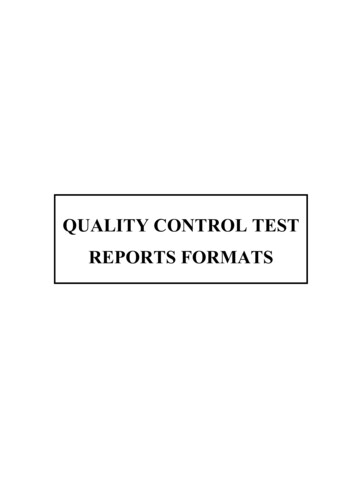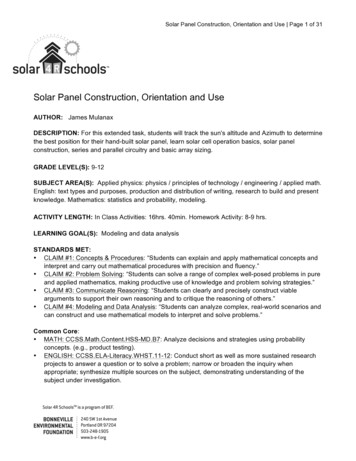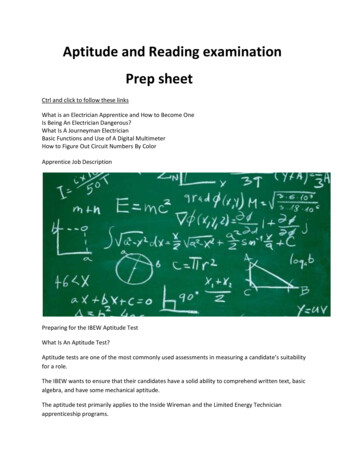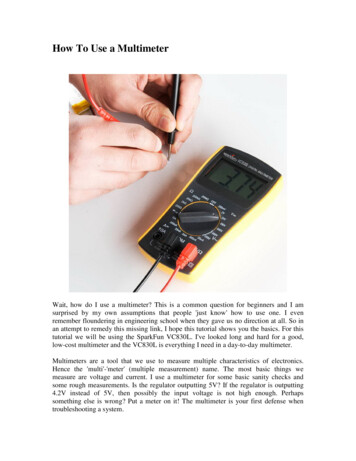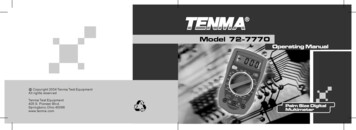
Transcription
How to Use a Multimeter a learn.sparkfun.comtutorialAvailable online at: http://sfe.io/t428ContentsIntroductionParts of a MultimeterProbe TypesMeasuring VoltageMeasuring ResistanceMeasuring CurrentContinuityChanging the FuseWhat Makes a Good Multimeter?Purchasing a MultimeterResources and Going FurtherIntroductionSo. how do I use a multimeter? This tutorial will show you how to use a digital multimeter (DMM),an indispensable tool that you can use to diagnose circuits, learn about other people's electronicdesigns, and even test a battery. Hence the 'multi'-'meter' (multiple measurement) name.The most basic things we measure are voltage and current. A multimeter is also great for somebasic sanity checks and troubleshooting. Is your circuit not working? Does the switch work? Put ameter on it! The multimeter is your first defense when troubleshooting a system. In this tutorial wewill cover measuring voltage, current, resistance and continuity.Suggested ReadingThese concepts may be helpful with this tutorial:How to use a Multi-meter Hand-outWhat is Electricity?Voltage, Current, Resistance, and Ohm's LawWhat is a circuit?Metric PrefixesHow to Use a BreadboardConnector BasisPolarityPage 1 of 36
Series and Parallel CircuitsAC vs DC currentPCB BasicsWe will be using the SparkFun VC830L throughout the tutorial, but these methods should apply tomost multimeters.Digital Multimeter - BasicTOL-12966 16.5023Favorited Favorite 54Wish ListVideoPage 2 of 36
Looking for the Multimeter that's right for you?We've got you covered!Digital Multimeter - BasicTOL-12966 16.5023Favorited Favorite 54Wish ListUSB Power Meter (Color TFT LCD)Page 3 of 36
TOL-15571 26.956Favorited Favorite 22Wish ListSmart SMD TesterTOL-10829 29.951Favorited Favorite 17Wish ListUSB Digital Multimeter - Auto-Ranging (RS232 Output)TOL-129676 RetiredFavorited Favorite 32Wish ListSee all of our Multimeter optionsParts of a MultimeterPage 4 of 36
A multimeter is has three parts:DisplaySelection KnobPortsThe display usually has four digits and the ability to display a negative sign. A few multimeters haveilluminated displays for better viewing in low light situations.The selection knob allows the user to set the multimeter to read different things such as milliamps(mA) of current, voltage (V) and resistance (Ω).Two probes are plugged into two of the ports on the front of the unit. COM stands for common andis almost always connected to Ground or ‘-’ of a circuit. The COM probe is conventionally black butthere is no difference between the red probe and black probe other than color. 10A is the specialport used when measuring large currents (greater than 200mA). mAVΩ is the port that the redPage 5 of 36
probe is conventionally plugged in to. This port allows the measurement of current (up to 200mA),voltage (V), and resistance (Ω). The probes have a banana type connector on the end that plugsinto the multimeter. Any probe with a banana plug will work with this meter. This allows for differenttypes of probes to be used.Using a Multimeter to test the voltage on a LiPo Battery.Probe TypesThere are many different types of probes available for multimeters. Here are a few of our favorites:Banana to Alligator Clips : These are great cables for connecting to large wires or pins on abreadboard. Good for performing longer term tests where you don’t have to have to hold theprobes in place while you manipulate a circuit.Banana to IC Hook : IC hooks work well on smaller ICs and legs of ICs.Page 6 of 36
Banana to Tweezers : Tweezers are handy if you are needing to test SMD components.Banana to Test Probes : If you ever break a probe, they are cheap to replace!Banana to IC Hook CablesCAB-00506 5.507Favorited Favorite 8Wish ListBanana to Alligator CableCAB-00509 4.503Favorited Favorite 17Wish ListMultimeter Probes - Needle TippedTOL-12078Page 7 of 36
5.5011Favorited Favorite 16Wish ListMultimeter Probes - TweezersTOL-11060 5.505Favorited Favorite 16Wish ListMeasuring VoltageTo start, let's measure voltage on a AA battery: Plug the black probe intoCOM and the red probeinto mAVΩ. Set the multimeter to "2V" in the DC (direct current) range. Almost all portableelectronics use direct current), not alternating current. Connect the black probe to the battery'sground or '-' and the red probe to power or ' '. Squeeze the probes with a little pressure against thepositive and negative terminals of the AA battery. If you've got a fresh battery, you should seearound 1.5V on the display (this battery is brand new, so its voltage is slightly higher than 1.5V).Page 8 of 36
If you're measuring DC voltage (such as a battery or a sensor hooked up to an Arduino) you want toset the knob where the V has a straight line. AC voltage (like what comes out of the wall) can bedangerous, so we rarely need to use the AC voltage setting (the V with a wavy line next to it). Ifyou're messing with AC, we recommend you get a non-contact tester rather than use a digitalmultimeter.Page 9 of 36
Use the V with a straight line to measure DC VoltageUse the V with a wavy line to measure AC VoltageWhat happens if you switch the red and black probes? The reading on the multimeter is simplynegative. Nothing bad happens! The multimeter measures voltage in relation to the common probe.How much voltage is there on the ‘ ’ of the battery compared to common or the negative pin? 1.5V.If we switch the probes, we define ‘ ’ as the common or zero point. How much voltage is there onthe ‘-’ of the battery compared to our new zero? -1.5V!Page 10 of 36
Now let's construct a simple circuit to demonstrate how to measure voltage in a real world scenario.The circuit is simply a 1kΩ and a Blue super bright LED powered with a SparkFun BreadboardPower Supply Stick. To begin, let's make sure the circuit you are working on is powered upcorrectly. If your project should be at 5V but is less than 4.5V or greater than 5.5V, this wouldquickly give you an indication that something is wrong and you may need to check your powerconnections or the wiring of your circuit.Page 11 of 36
Measuring the voltage coming off of a Power Supply Stick.Set the knob to "20V" in the DC range (the DC Voltage range has a V with a straight line next to it).Multimeters are generally not autoranging. You have to set the multimeter to a range that it canmeasure. For example, 2V measures voltages up to 2 volts, and 20V measures voltages up to 20volts. So if you've measuring a 12V battery, use the 20V setting. 5V system? Use the 20V setting. Ifyou set it incorrectly, you will probably see the meter screen change and then read '1'.Page 12 of 36
With some force (imagine poking a fork into a piece of cooked meat), push the probes onto twoexposed pieces of metal. One probe should contact a GND connection. One probe to the VCC or5V connection.We can test different parts of the circuit as well. This practice is callednodal analysis, and it is abasic building block in circuit analysis. By measuring the voltage across the circuit we can see howmuch voltage each component requires. Let's measure the whole circuit first. Measuring fromwhere the voltage is going in to the resistor and then where ground is on the LED, we should seethe full voltage of the circuit, expected to be around 5V.Page 13 of 36
We can then see how much voltage the LED is using. This is what is referred to as thevoltagedrop across the LED. If that doesn't make sense now, fear not. It will as you explore the world ofelectronics more. The important thing to take away is that different parts of a circuit can bemeasured to analyze the circuit as a whole.Page 14 of 36
This LED is using 2.66V of the available 5V supply to illuminate. This is lower than the forwardvoltage stated in the datasheet on account of the circuit only having small amount of currentrunning though it, but more on that in a bit.OverloadWhat happens if you select a voltage setting that is too low for the voltage you're trying to measure?Nothing bad. The meter will simply display a 1. This is the meter trying to tell you that it isoverloaded or out-of-range. Whatever you're trying to read is too much for that particular setting.Try changing the multimeter knob to a the next highest setting.Reading the 5V across this circuit is too much for the 2V setting on the multimeter.Selection KnobPage 15 of 36
Why does the meter knob read 20V and not 10V? If you're looking to measure a voltage less than20V, you turn to the 20V setting. This will allow you to read from 2.00 to 19.99.The first digit on many multimeters is only able to display a '1' so the ranges are limited to19.99instead of 99.99. Hence the 20V max range instead of 99V max range.Warning! In general, stick to DC circuits (the settings on the multimeter with straight lines, notcurvy lines). Most multimeters can measure AC (alternating current) systems, but AC circuits can bedangerous. A wall outlet with AC or 'main voltage' is the stuff that can zap you pretty good. VERYcarefully respect AC. If you need to check to see if an outlet is 'on' then use a AC tester. Really theonly times we've needed to measure AC are when we've got an outlet that is acting funny (is itreally at 110V?), or if we're trying to control a heater (such as a hot plate). Go slow and doublecheck everything before you test an AC circuit.Measuring ResistancePage 16 of 36
Normal resistors have color codes on them. If you don't know what they mean, that's ok! There areplenty of online calculators that are easy to use. However, if you ever find yourself without internetaccess, a multimeter is very handy at measuring resistance.Pick out a random resistor and set the multimeter to the 20kΩ setting. Then hold the probes againstthe resistor legs with the same amount of pressure you when pressing a key on a keyboard.The meter will read one of three things, 0.00, 1, or the actual resistor value.In this case, the meter reads 0.97, meaning this resistor has a value of 970Ω, or about 1kΩ(remember you are in the 20kΩ or 20,000 Ohm mode so you need to move the decimal threeplaces to the right or 970 Ohms).If the multimeter reads 1 or displays OL, it's overloaded. You will need to try a higher modesuch as 200kΩ mode or 2MΩ (megaohm) mode. There is no harm if this happen, it simplymeans the range knob needs to be adjusted.Page 17 of 36
If the multimeter reads 0.00 or nearly zero, then you need to lower the mode to2kΩ or 200Ω.Remember that many resistors have a 5% tolerance. This means that the color codes may indicate10,000 Ohms (10kΩ), but because of discrepancies in the manufacturing process a 10kΩ resistorcould be as low as 9.5kΩ or as high as 10.5kΩ. Don't worry, it'll work just fine as a pull-up or generalresistor.Let's drop the meter down to the next lowest setting, 2KΩ. What happens?Not a whole lot changed. Because this resistor (a 1KΩ) is less than 2KΩ, it still shows up on thedisplay. However, you'll notice that there is one more digit after the decimal point giving us a slightlyhigher resolution in our reading. What about the next lowest setting?Page 18 of 36
Now, since 1kΩ is greater than 200Ω, we've maxed out the meter, and it is telling you that it isoverloaded and that you need to try a higher value setting.As a rule of thumb, it's rare to see a resistor less than 1 Ohm. Remember that measuring resistanceis not perfect. Temperature can affect the reading a lot. Also, measuring resistance of a devicewhile it is physically installed in a circuit can be very tricky. The surrounding components on a circuitboard can greatly affect the reading.Measuring CurrentReading current is one of the trickiest and most insightful readings in the world of embeddedelectronics. It's tricky because you have to measure current in series. Where voltage is measure bypoking at VCC and GND (in parallel), to measure current you have to physically interrupt the flow ofcurrent and put the meter in-line. To demonstrate this, we'll use the same circuit we used in themeasuring voltage section.Page 19 of 36
The first thing we'll need is an extra piece of wire. As mentioned, we'll need to physically interruptthe circuit to measure the current. Said another way, pull out the VCC wire going to the resistor,add a wire where that wire was connected, and then probe from the power pin on the power supplyto the resistor. This effectively "breaks" power to the circuit. We then insert the multimeter in-line sothat it can measure the current as it "flows" through to the multimeter into the bread board.For these pictures, we cheated and used alligator clips. When measuring current, it's often good towatch what your system does over time, for a few seconds or minutes. While you might want tostand there and hold the probes to the system, sometimes it's easier to free up your hands. Thesealligator clip probes can come in handy. Note that almost all multimeters have the same sized jacks(they're called "banana plugs") so if you're in a pinch, you can use your friend's probes.With the multimeter connected, we can now set the dial to the proper setting and measure somecurrent. Measuring current works the same as voltage and resistance -- you have to get the correctrange. Set the multimeter to 200mA, and work from there. The current consumption for manybreadboard projects is usually under 200mA. Make sure the red probe is plugged into the 200mAPage 20 of 36
fused port. On our favorite multimeter, the 200mA hole is the same port/hole as voltage andresistance reading (the port is labeled mAVΩ). This means you can keep the red probe in the sameport to measure current, voltage, or resistance. However, if you suspect that your circuit will beusing close to or more than 200mA, switch your probe to the 10A side, just to be safe. Overloadingthe current can result in a blown fuse rather than just an overload display. More on that in a bit.This circuit was only pulling 1.8mA at the time of measurement, not a lot of current. The averagereading was closer to 2.1mA.Realize that the multimeter is acting as a piece of wire -- you've now completed the circuit, and thecircuit will power on. This is important because as time goes on the LED, microcontroller, sensor, orwhatever device being measured may change its power consumption (such as turning on an LEDcan resulting in a 20mA increase for a second, then decrease for a second when it turns off). On themultimeter display you should see the instantaneous current reading. All multimeters take readingsover time and then give you the average, so expect the reading to fluctuate. In general, cheapermeters will average more harshly and respond more slowly, so take each reading with a grain ofPage 21 of 36
salt. In your head, take an average range such as 7 to 8mA under normal 5V conditions (not7.48mA).Similar to the other measurements, when measuring current, the color of the probes does notmatter. What happens if we switch probes? Nothing bad happens! It simply causes the currentreading to become negative:Current is still flowing through the system, you've just changed your perspective and now the meterreads negative.Remember! When you're done using the meter, always return the meter to read voltage (return theprobes to the voltage port, set the meter to read the DC voltage range if necessary). It's common tograb a meter and begin to quickly measure the voltage between two pins. If you have left yourmeter in 'current' mode, you won't see the voltage on the display. Instead you'll see '0.000'indicating that there is no current between VCC and GND. Within that split second you will haveconnected VCC to GND through your meter and the 200mA fuse will blow not good. So beforePage 22 of 36
you put the meter down for the night, remember to leave your meter in a friendly state.Measuring current can be tricky the first couple of times. Don't worry if you blow the fuse - we'vedone it dozens of times! We'll show you how to replace the fuse in a later section.ContinuityContinuity testing is the act of testing the resistance between two points. If there is very lowresistance (less than a few Ωs), the two points are connected electrically, and a tone is emitted. Ifthere is more than a few Ωs of resistance, than the circuit is open, and no tone is emitted. This testhelps insure that connections are made correctly between two points. This test also helps us detectif two points are connected that should not be.Continuity is quite possibly the single most important function for embedded hardware gurus. Thisfeature allows us to test for conductivity of materials and to trace where electrical connections havebeen made or not made.Set the multimeter to 'Continuity' mode. It may vary among DMMs, but look for a diode symbol withpropagation waves around it (like sound coming from a speaker).Page 23 of 36
Multimeter is set to continuity mode.Now touch the probes together. The multimeter should emit a tone (Note: Not all multimeters havea continuity setting, but most should). This shows that a very small amount of current is allowed toflow without resistance (or at least a very very small resistance) between probes.Warning! In general, turn OFF the system before checking for continuity.On a breadboard that is not powered, use the probes to poke at two separate ground pins. Youshould hear a tone indicating that they are connected. Poke the probes from the VCC pin on amicrocontroller to VCC on your power supply. It should emit a tone indicating that power is free toflow from the VCC pin to the micro. If it does not emit a tone, then you can begin to follow the routethat copper trace takes and tell if there are breaks in the line, wire, breadboard, or PCB.Continuity is a great way to test if two SMD pins are touching. If your eyes can't see it, themultimeter is usually a great second testing resource.Page 24 of 36
When a system is not working, continuity is one more thing to help troubleshoot the system. Hereare the steps to take:1. If the system is on, carefully check VCC and GND with the voltage setting to make sure thevoltage is the correct level. If the 5V system is running at 4.2V check your regulator carefully,it could be very hot indicating the system is pulling too much current.2. Power the system down and check continuity between VCC and GND. If there is continuity (ifyou hear a beep), then you've got a short somewhere.3. Power the system down. With continuity, check that VCC and GND are correctly wired to thepins on the microcontroller and other devices. The system may be powering up, but theindividual ICs may be wired wrong.4. Assuming you can get the microcontroller running, set the multimeter aside, and move on toserial debugging or use a logic analyzer to inspect the digital signals.Continuity and large capacitors: During normal troubleshooting. you will be probing for continuitybetween ground and the VCC rail. This is a good sanity check before powering up a prototype tomake sure there is not a short on the power system. But don't be surprised if you hear a short'beep!' when probing. This is because there is often significant amounts of capacitance on thepower system. The multimeter is looking for very low resistance to see if two points are connected.Capacitors will act like a short for a split second until they fill up with energy, and then act like anopen connection. Therefore, you will hear a short beep and then nothing. That's ok, it's just the capscharging up.Changing the FuseOne of the most common mistakes with a new multimeter is to measure current on a bread boardby probing from VCC to GND (bad!). This will immediately short power to ground through themultimeter causing the bread board power supply to brown out. As the current rushes through themultimeter, the internal fuse will heat up and then burn out as 200mA flows through it. It will happenin a split second and without any real audible or physical indication that something is wrong.Wow, that was neat. Now what? Well first, remember that measuring current is done in series(interrupt the VCC line to the breadboard or microcontroller to measure current). If you try tomeasure the current with a blown fuse, you'll probably notice that the meter reads '0.00' and that thesystem doesn't turn on like it should when you attach the multimeter. This is because the internalfuse is broken and acts as a broken wire or open. Don't worry, this happens all the time, and it costsabout 1 to fix.To change the fuse, find your handy dandy mini screw driver, and start taking out screws. TheSparkFun DMM is pretty easy to pull apart. Start by removing the battery plate and the battery.Page 25 of 36
Next, remove the two screws hiding behind the battery plate.Page 26 of 36
Lift the face of the multimeter slightly.Page 27 of 36
Now notice the hooks on the bottom edge of the face. You will need to slide the face sideways witha little force to disengage these hooks.Page 28 of 36
Once the face is unhooked, it should come out easily. Now you can see inside the multimeter!Page 29 of 36
Gently lift up on the fuse, and it will pop out.Page 30 of 36
Make sure to replace the correct fuse with the correct type. In other words, replace the 200mAfuse with a 200mA fuse.Warning! DO NOT put a 10A fuse where a 200mA fuse should go.The placement of the fusesmay not match the placement of the probe ports. Read the metal cap on either end of the fuse todouble check which is which.The components and PCB traces inside the multimeter are designed to take different amounts ofcurrent. You will damage and possibly ruin your multimeter if you accidentally push 5A through the200mA port.There are times where you need to measure high current devices like a motor or heating element.Do you see the two places to put the red probe on the front of the multimeter? 10A on the left andmAVΩ on the right? If you try to measure more than 200mA on themAVΩ port you run the risk ofblowing the fuse. But if you use the 10A port to measure current, you run a much lower risk ofblowing the fuse. The trade-off is sensitivity. As we talked about above, by using the 10A port andPage 31 of 36
knob setting, you will only be able to read down to 0.01A or 10mA. Most of my systems use morethan 10mA so the 10A setting and port works well enough. If you're trying to measure very lowpower (micro or nano amps) the 200mA port with the 2mA, 200uA, or 20uA could be what youneed.Remember: If your system has the potential to use more than 100mA you should start with the redprobe plugged into the 10A port and 10A knob setting.With sub 50 digital multimeters, the measurements you are likely to take are just trouble shootingreadings, not scientific experimental results. If you really need to see how the IC uses current orvoltage over time, use an Agilent or other high quality bench unit. These units have higher precisionand offer a wide range of fancy functions (some include Tetris!). Bunnie Huang, hardware designerbehind Chumby, uses high-precision current readings to trouble shoot boards during the finaltesting procedures of a Chumby. By looking at the current consumption of different boards that havefailed (for example a given failed board uses 210mA over the normal), he could identify what waswrong with the board (when the RAM fails, it generally uses 210mA over normal). By pinpointingPage 32 of 36
what may be potentially wrong, the rework and repair of boards is made much easier.What Makes a Good Multimeter?Everyone has his or her preference, but in general multimeters that have continuity are preferred.Every other feature is just icing on the cake.There are fancy multimeters that are autoranging, meaning they automatically change theirinternal range to attempt to find the correct voltage, resistance, or current of the thing you're pokingat. Auto-ranging can be very helpful if you know how to use it. Generally speaking, autorangingmultimeters are higher quality and generally have more features. So if someone gives you amultimeter with auto-range, put it to use! Just know how to get it into manual mode. A circuit'svoltage or current can fluctuate quite quickly. With some of the systems, the current or voltage is sosporadic that the auto-range can't keep up sensibly.A back-lit LCD is fancy, but when was the last time you measured your circuit in the dark? Wegenerally steer clear of scary forests and situations that require us to test stuff in the middle of thenight, but some people may want or need a dark-friendly multimeter.A good click on the range selector is actually a major plus in our book. A soft knob is usuallyindicative of a shoddy meter.Decent probes are a plus. Over time the leads will tend to break down at the flex point. We'veseen wires come completely out of probes - and it's always at the moment you need the probes towork! If you do break a probe, they are reasonably cheap to replace.Auto-off is a great feature that is rarely seen on cheaper multimeters. This is a feature that canbenefit beginners and advanced users alike, as it's easy to forget to turn the meter off at 2AM. TheSparkFun digital multimeter doesn't have this feature, but luckily the meter is very low-power. We'veleft the multimeter for two days straight before the 9V battery began to get low. That said, don'tforget to turn your meter off!Page 33 of 36
You're now ready to use your digital multimeter to start measuring the world around you. Feel freeto start using it to answer many questions. I believe my LED is getting 20mA, is it really? How muchvoltage does a lemon have? Is a glass of water conductive? Can I use aluminum foil to replacethese wires? A digital multimeter will answer these and many more questions about electronics.Purchasing a MultimeterA digital multimeter is an essential tool in every electronic enthusiasts arsenal. Here are a fewmultimeters and kits with multimeters to suit the needs of beginners and experienced hobbyistsalike.Our Recommendations:Digital Multimeter - BasicTOL-12966 16.5023Favorited Favorite 54Wish ListSparkFun Deluxe Tool KitTOL-11805 246.50Favorited Favorite 21Wish ListPage 34 of 36
USB Digital Multimeter - Auto-Ranging (RS232 Output)TOL-129676 RetiredFavorited Favorite 32Wish ListMooshimeterTOL-1384314 RetiredFavorited Favorite 46Wish ListClick to Browse Additional Multimeter OptionsInterested in learning more foundational topics?See our Engineering Essentials page for a full list of cornerstone topics surrounding electricalengineering.Take me there!Page 35 of 36
Resources and Going FurtherNow that you know the basics of how to use a digital multimeter, check out these tutorials to useyour new skill:Testing LED and Diode Polarity with a MultimeterLEDsDiodesElectric PowerBattery TechnologiesPowering Your ProjectOr check out some of these related blog posts.Fluke, we love you but you're killing us.March 19, 2014Favorited Favorite 1Fluke Responds to Trademark ProblemsMarch 20, 2014Favorited Favorite 1Enginursday: Linear Regulator Thermal TestsAugust 25, 2016Favorited Favorite 1learn.sparkfun.com CC BY-SA 3.0 SparkFun Electronics Niwot, ColoradoPage 36 of 36
4.95 11 Favorited Favorite 15 Wish List Multimeter Probes - Tweezers TOL-11060 4.95 5 Favorited Favorite 16 Wish List Measuring Voltage To start, let's measure voltage on a A
